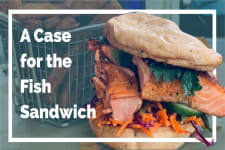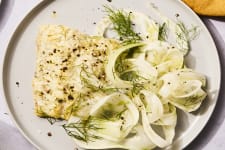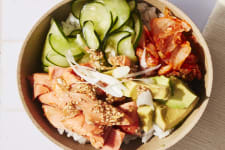A note from Founder & CEO Arron Kallenberg: At Wild Alaskan Company, we honor salmon as the lifeblood of multiple ecosystems. The natural journey salmon take during their lifetimes transfers nutrients from the oceans to the rivers, lakes and streams. It’s that very journey that makes wild salmon such a powerhouse of nutrients and color. In contrast, farmed salmon are raised in stagnant, manmade systems that try (and fail) to recreate what nature does best. When it comes to our health and the health of our oceans, we believe nature does know best, and we strive to participate in the natural process in a responsible, sustainable way. We’re exploring the fundamental reasons we believe sustainably-managed wild salmon is the best choice for you and the planet. Read on for more.
There’s a common misconception that farmed salmon is a sustainable choice of seafood when compared to wild salmon fisheries, especially in regard to overfishing. The idea of harvesting fish raised in a farmed environment sounds inherently less destructive to the ecosystem than harvesting fish from the wild. Unfortunately, it’s not.
The word “farm” can bring to mind an idyllic system where we have the ability to cultivate and harvest what we need from the earth and sea, leaving the pristine wilderness untouched. But as the evidence suggests, the reality is that neither salmon farms nor wild fisheries exist in a vacuum.
Here are a few key reasons why wild salmon from responsibly-managed fisheries is the only choice when it comes to sustainability.
The Rundown: Wild Salmon over Farmed Salmon
-
Wild salmon fisheries can help ecosystems recover from overfishing.
-
Farmed salmon operations typically rely upon fish feed that has been sourced unsustainably.
-
Wild salmon are harvested as part of a sustainable, supply-driven food system that is resilient and responsive to natural fluctuations in populations from season to season.
-
Farmed salmon are cultivated to meet the unsustainable requirements of a demand-driven food system.
-
Wild salmon have a life cycle that is part of the natural cycles within its ecosystem.
-
Farmed salmon operations have a life cycle that produces high concentrations of pollution and waste toxic to surrounding ecosystems.
-
Wild salmon fisheries that are well managed are designed around rigorous, science-based data to ensure that harvest practices are sustainable.
-
Farmed salmon systems cannot be sustainable at this time, even when technological advances are adopted by the industry.
Farmed salmon operations can actually fuel overfishing.
Farmed Atlantic salmon are fed engineered feed made from corn and soy. But this unnatural, plant-based feed must be supplemented with wild fish derivatives for farmed salmon to mimic the unique natural color of salmon.
Harvesting wild forage fish for fish meal creates competition between farmed and wild salmon for finite resources, putting undue pressure on wild species to survive. In other words, salmon farm operations are inextricably tied to wild fish, in ways that can accelerate the overfishing of our oceans.
In contrast, responsible wild fisheries — like those in Alaska — are designed to prevent overfishing, as well as support and even improve the greater stability of the marine ecosystems by adhering to strict gear and seasonal restrictions that are designed to protect the integrity of habitats and limit bycatch. These well-managed fisheries ensure that no more fish are harvested from the ecosystem than it can sustain over generations.
Responsible management doesn’t just maintain the status quo, though. From a generational standpoint, recent research has found that intensive management of wild fisheries can actually help overfished populations recover and allow healthy populations to sustain themselves indefinitely, while still providing us with bountiful harvests each year.
The demand-driven food system of salmon farms is unsustainable because natural resources they rely on are finite.
Today, the salmon aquaculture industry is the fastest growing system of food production, expanding to meet the demands of the consumer market. As it grows, the pressure on wild forage fish stocks will also increase. The problem is that wild forage fish are a finite resource. To get around this limitation, some operations are moving toward vegetarian fish feeds formulated with plant-based alternatives to fish oil.
Taken at face value, these feeds sound like a sustainable alternative to conventional feed. But vegetarian feed is fraught with its own environmental impact. The soy and corn used in vegetarian fish feed, for instance, may be sourced from industrial farms that pollute or deplete vital resources like water and land.
One recent report cited serious controversies over the production of soy for fish and animal feeds. The increased global demand for soy has, in some cases, led directly to increased deforestation and loss of biodiversity as ecologically critical forests like the Amazon are cleared to make way for cropland.
Market demands have long since transformed landscapes, and continue to threaten our remaining natural resources. The forestalled Pebble Mine Project, for instance, has been an existential threat to Bristol Bay in Southwest Alaska, the world’s largest sockeye salmon spawning grounds.
The same report noted that nearly all of the environmental impact associated with aquaculture systems that rely upon fish feed can be traced back to the fish feed itself. Relieving pressure on marine resources has simply shifted pressure to terrestrial ones, as demand for resources continues to outpace a sustainable supply. Until the aquaculture industry can resolve this fish feed problem, it has a significant sustainability problem.
In contrast, well-managed wild fisheries support a sustainable supply-driven food system, only offering to consumers what nature can sustain from season to season. (After all, healthy wild fisheries may be abundant, but their resources are still finite.) A supply-driven food system is more aligned with the natural fluctuations of abundance in the wild and is resilient to booms as well as drops in fish populations. Harvest quotas are set and reset every year in response to the latest data that allows a natural resource to sustain itself indefinitely. Following these guidelines can lead to an outright pause on the harvest of a particular species for several seasons until their numbers can recover.
Open pen salmon farms release toxic pesticides into pristine ecosystems that threaten local flora and fauna.
Conventionally, salmon farms are designed as open pens at sea. This means that the surrounding ecosystems are exposed to the large concentrations of waste that are produced in these pens, including pollution from pesticides, antibiotics, excess food, and feces, all of which have a negative effect on the environment.
Pesticides, like the ones used to treat sea lice infestations common in fish farms, pollute surrounding ecosystems and threaten the survival of wild species to whom these pesticides are extremely toxic. Shellfish, which are an important source of food for many species in the food web, are at particular risk to this toxicity. Without shellfish, many wild species will not have the resources they need to survive. These pesticides are also creating pests resistant to chemical treatment, ultimately limiting the efficacy of chemicals in controlling sea lice populations.
Antibiotic use in salmon farms is fueling the rise of antibiotic-resistant bacteria, which poses a danger to global health and food security.
Both the World Health Organization and CDC have come to a clear determination about antibiotic resistance being one of the biggest modern threats to global health, food security, and development. Healthy societies need to be able to rely on effective antibiotics to treat medical threats, but antibiotic overuse has led to the formation of bacteria that resist standard treatments, leading to a rise in complications and fatalities.
Reliance upon antibiotics is a problem that often occurs in unsustainable food systems. Farmed salmon are not evolutionarily suited to confinement, and are more vulnerable to diseases that require treatment with antibiotics. Salmon farming is a massive industry, so one can only imagine the large inputs of antibiotics required to keep farmed stock healthy.
Keeping farmed salmon healthy can lead to the contamination of the surrounding ecosystem. One report from 2018 found that a high concentration of antibiotics was being released into the protected waters of Chilean Patagonia. Antibiotic-resistant microbiota are now thriving in this formerly pristine ecosystem, and this may pose a threat to flora and fauna who have not evolved to coexist with these microbiota. Irresponsible farming practices are fueling a rise in antibiotic-resistant bacteria in other industries as well. For example, one report found that over 40 percent of antibiotics purchased in the United States are used to treat livestock rather than for medical use among humans.
It should go without saying, but wild salmon populations don’t need any antibiotics to be healthy. They naturally thrive in clean, balanced ecosystems.
To date, there is no sustainable model of design for salmon farms.
Salmon farms have a negative ecological impact, full stop. There’s no economically and ecologically viable model for sustainable design at this time, despite consistent advances in technology that are striving to move the needle. This is one key reason why fish farming is illegal in the State of Alaska. In contrast, shellfish farms are legal in Alaska, since they can be designed in a way that does not negatively affect, and can even improve, local ecosystems.
Well-managed wild fisheries, like those in Alaska, integrate rigorous, science-based restrictions into their design and operate with oversight from independent third parties to ensure that salmon populations and their ecosystems are protected for future generations.
It’s important to emphasize that poorly managed wild fisheries can be unsustainable and destructive to the ecosystem. When wild fisheries operate unchecked, their practices can deplete fish populations beyond recovery, destroy critical habitats, and ultimately hasten their own end.
The State of Alaska is serious about ensuring the sustainability of its fishing industry: since gaining statehood, its State Constitution has included clauses that explicitly require wild fisheries to operate on the sustained yield principle — meaning that the resources of the sea should be able to sustain themselves indefinitely, even as we harvest them to sustain ourselves. This is why Alaska’s fishing industry is considered the global gold standard.
Ultimately, being the gold standard is not just a matter of pride. It’s a matter of survival, for generations to come.
Buy Wild, Sustainable Salmon
Enjoy sustainbly-harvested salmon by opting for wild-caught varieties sourced from Alaska. Buy a wild-caught salmon box today. Also, consider giving the gift of wild salmon to friends and family. Sending the gift of Alaskan seafood to your loved ones is a thoughtful way to show you care.






